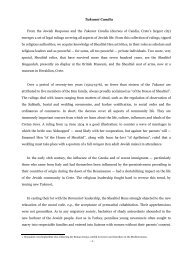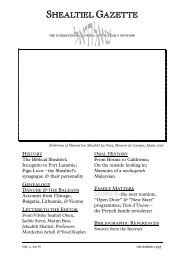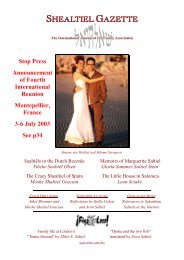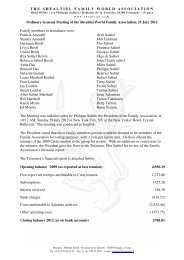a thesis by Flora Jane Satt - Shealtiel
a thesis by Flora Jane Satt - Shealtiel
a thesis by Flora Jane Satt - Shealtiel
You also want an ePaper? Increase the reach of your titles
YUMPU automatically turns print PDFs into web optimized ePapers that Google loves.
<strong>Flora</strong> <strong>Jane</strong> <strong>Satt</strong>—annotated <strong>by</strong> Miles SaltielPart I, The PlaceCotopaxi, a small, unincorporated village on the banks of the ArkansasRiver, has been the scene of an unusual chapter in Coloradohistory. This oddly-named town, today just a “whistle-stop”on the Denver and Rio Grande Western Railroad, thirty-threemiles west of Cañon City in Fremont County, is mentioned inmany encyclopedias and books on American agricultural colonies.Environmental factors are always important in analyzing an historicalepisode, but particularly in the case of the colony foundedhere because its failure has been attributed solely to these factors.The naming, founding and description of its physical features arenecessary for an appreciation of Cotopaxi’s role in this history.The man responsible for the strange name was Henry Thomas,known to contemporaries as “Gold Tom”. He was an itinerantprospector who left the Central City gold camp in 1867, andcrossed the Divide to investigate the Upper Arkansas Valleyaround California Gulch. There he conceived the idea that some ofthe heavier gold might have washed downstream so he continuedsouth along the river, reaching the forks near the present site ofSalida about 1870. At the same time, the Denver and Rio GrandeRailroad began its survey of a proposed transcontinental routethrough the Arkansas Valley By October 31, 1872 track had beenlaid as far west on this route as Labran, seven miles east of CañonCity , and Henry Thomas had taken a job with the railroad to augmenthis meager prospecting income. His duties included procuringtimber for ties and this meant he had to scout not only the regionthen being graded but neighboring valleys and mountains.Particularly struck <strong>by</strong> one of these valleys as closely resembling anarea he had once prospected in northern Ecuador, he named theColorado counterpart after the dominant Andean geographic feature,a volcano called “Cotopaxi”. At the juncture of the smalltributary streams which flow into the Arkansas River at Cotopaxi,Colorado, looking westward through the narrow canyon of theAnnotationsI have recently learned that <strong>Flora</strong> <strong>Jane</strong><strong>Satt</strong> (<strong>Satt</strong> hereinafter) survives, but Ihave been unable to make direct contactwith her. I here<strong>by</strong> acknowledge her rightsas the author of the original material andapologise to her for editing it without herpermission. Needless to say, she has noresponsibility for my work. I have left hertext but removed her notes, which goprincipally to sources, to make room formy comments. I have also providedappendices as follows:1.Notes on sources2.Timeline3. Summary of allegationsMy commentary relies on a close readingof <strong>Satt</strong> in combination with othersources. These particularly include apreviously overlooked contemporaneousreport <strong>by</strong> Julius Schwarz, the agent of theHebrew Emigrant Aid Society, thepromoters of the colony and its selfstyledGeneral Manager.To summarise my understanding, theCotopaxi settlement was promoted amida climate of euphoria about the prospectsfor settling the high plains and the scopefor Jewish participation in agriculture.Like every other Jewish agriculturalcolony in the U.S., it was doomed tofailure. In this case, the settlement wasunderfinanced and the colonists had littlebackground in farming and none in thesocial, legal or geographical conditions ofthe high plains, which combined tothwart them.The would-be pioneers were no helplessvictims; some were former proprietorsand business-people. They had lost mostof their resources in the politicalturbulence of Tsarist Russia and thebalance over a winter of inactivity in NewYork City. They turned up in Cotopaxidestitute, after changing their plans fromstock-raising to agriculture—unsuited forthe locality. On arrival they contrived tolose an ox-team on the way to theirfarmsteads, then giving up good land andwater rights to prior settlers, crops toroaming cattle, and winter supplies tobears and tribesmen. They sowed cropsthree months into a four-month growingseason and survived on credit estimatedat between $1,545 and $8,000 togetherwith wages from the Denver and RioGrande Railroad, where Schwarz hadarranged work for them.Within half a year or so of their arrivalthey were in touch with a Denverattorney and campaigning against Saltielin the Denver press and directly to HEAS.This was either for more credit, orforgiveness of their obligations to Saltielor to HEAS, or for the grubstake theyobtained once it became clear that thecolony was not viable. This created atradition of demonisation which persiststo this day, principally driven <strong>by</strong> <strong>Satt</strong>’saccount.Please note: All page referencesto <strong>Satt</strong> are to this document.1








